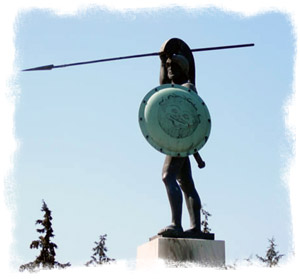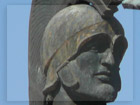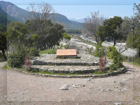
 |
| MAIN |
| Introduction |
| Greek Preparations |
| Armies |
| Battlefield |
| Battle |
| Aftermath |
| Date |
| Monuments |
| COMPLEMENTARY |
| Thermopylae |
| Leonidas I |
| Xerxes I |
| Sparta |
| Thespiae |
| Molon Labe |
| Leonidas
I |
||
|
Leonidas (Greek: Λεωνίδας - "Lion's son", "Lion-like") was a king of Sparta, the 17th of the Agiad line, one of the sons of King Anaxandridas II of Sparta, who was believed to be a descendant of Heracles. He succeeded his half-brother Cleomenes I, probably in 489 or 488 BC, and was married to Cleomenes' daughter, Gorgo. His name was raised to a heroic and legendary status as a result of the events in the Battle of Thermopylae. In 480 the ephors sent Leonidas with the 300 men of an all-sire
unit (soldiers who had sons to According to Herodotus, Leonidas' wife Gorgo asked him how she could aid his mission. He responded "marry a good man, bear good children, and live a good life." Several episodes demonstrate the laconic matter-of-fact bravery that famed Leonidas and the Spartans. On the first day of the siege Xerxes demanded the Greeks surrender their arms. Leonidas replied "Come and get them" ("Molon Labe"). This phrase has been re-used by generals and politicians throughout history and often repeated in popular culture. On the third day, the king exhorted his men to eat a hearty breakfast, because that night they would dine in Hades. Leonidas' men repulsed the frontal attacks of the Persians for the first two days, but when the Malian Ephialtes led the Persian general Hydarnes by a mountain track to the rear of the Greeks, Leonidas divided his army. The King himself remained in the pass with his 300 Spartans and 400 Thebans, along with 700 Thespians who refused to leave. Leonidas' intent was to delay the Persians, sacrificing himself and his men. The little Greek force, attacked from both sides, was cut down to a man except for the Thebans, who surrendered. One theory is that Leonidas sent the remainder of his men home to preserve troops for future battles. The soldiers who stayed behind were to protect their escape from the Persian cavalry. Leonidas fell in the thickest of the fight, but the Spartans retrieved his body and protected it until their final fall to enemy arrows. Herodotus says that Leonidas' head was cut off by Xerxes' order and his body crucified, due to his alleged hatred towards the Persian King. This was considered sacrilege towards Leonidas, and unusual action on Xerxes' part.
After the departure and defeat of the Persians, the Greeks collected their dead and buried them on the hill. A stone lion was erected to commemorate Leonidas. Forty years after the battle, Leonidas' body was returned to Sparta where he was buried again with full honors and funeral games were held every year in his memory. A carved lion monument bearing the inscription below was dedicated at his death site commemorating the sacrifice of him and his men: "Go, tell the Spartans, stranger passing by,
Permission is granted to copy, distribute and/or modify this article under the terms of the GNU Free Documentation License, Version 1.2 or any later version published by the Free Software Foundation.
(What does it mean?)
The text is based on material from the Wikipedia article "Battle of Thermopylae". Modifications, additions to the Wikipedia text and all the photos by the website author. |
 carry on their bloodline) and 6700
allies to hold the pass of Thermopylae against the hundreds of
thousands of Persian soldiers who had invaded from the north of
Greece under Xerxes. Contemporary accounts claim Leonidas took
his small personal fighting unit because Spartan religious customs
forbade sending an army at that time of year. In addition, he was
deliberately going to his doom: an oracle had foretold that Sparta
could be saved only by the death of one of its kings, one of the
lineage of Hercules. Instead it seems likely that the ephors supported
the plan half-heartedly due to the festival of Carneia and their
policy of concentrating the Greek forces at the Isthmus of Corinth.
carry on their bloodline) and 6700
allies to hold the pass of Thermopylae against the hundreds of
thousands of Persian soldiers who had invaded from the north of
Greece under Xerxes. Contemporary accounts claim Leonidas took
his small personal fighting unit because Spartan religious customs
forbade sending an army at that time of year. In addition, he was
deliberately going to his doom: an oracle had foretold that Sparta
could be saved only by the death of one of its kings, one of the
lineage of Hercules. Instead it seems likely that the ephors supported
the plan half-heartedly due to the festival of Carneia and their
policy of concentrating the Greek forces at the Isthmus of Corinth.
